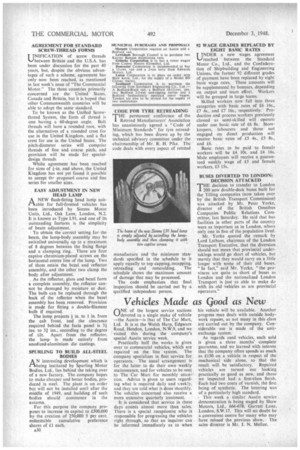AGREEMENT FOR STANDARD SCREW-THREAD FORMS
Page 32

If you've noticed an error in this article please click here to report it so we can fix it.
UNIF1CATION of screw threads between Britain and the U.S.A. has been under discussion for the past 40 years, but, despite the obvious advantages of such a scheme, agreement has only now been reached, as mentioned in last week's issue of "The Commercial Motor." The three countries primarily concerned are the United States, Canada and Britain, but it is hoped that other Commonwealth countries will be able to adopt the same standard.
To be known as the Unified Screwthread System, the form of thread is one having a 60-degree angle. Bolt threads will have a rounded root, with the alternatives of a rounded crest for use in the United Kingdom, and a flat crest for use in the United States. The pitch-diameter series will comprise threads of fine and coarse pitch, and provision will be made for specialdesign threads
Whilst agreement has been reached for sizes of 1-in. and above, the United Kingdom has not yet found it possible to accept the nroposed coarse and fine• series for smaller sizes.
EASY ADJUSTMENT IN NEW HEAD LAMP
ANEW flush-fitting head lamp suitable for full-fronted vehicles has been introduced by Simms Motor Units, Ltd., Oak Lane, London, N.2. it is known as Type L91, and one of its outstanding features is the simplicity of beam adjustment.
To obtain the correct setting for the beam, the lamp-body assembly may be swivelled universally up to a maximum of 8 degrees between the fixing flange and a clamping ring. There are four captive chromium-plated screws on the horizontal centre line of the lamp. Two of them retain the bezel and reflector assembly, and the other two clamp the body after adjustment.
As the reflector, glass and bezel form a complete assembly, the reflector cannot be damaged by moisture or dust. The bulb can be replaced through the back of the 'reflector when the bezel assembly has been removed. Provision is made for fitting a double-filament bulb if required.
The lamp projects in. to 1 in. from the cab front, and the clearance required behind the facia panel is 31 ins. to 31 ins., according to the degree of tilt. Apart from the reflector, the lamp is made entirely from anodized-aluminium die castings.
SPURLING TO BUILD ALL-STEEL BODIES
AN interesting development which is being instituted by Spurling Motor Bodies, Ltd., lies behind the taking over of a new factory. The company hopes to make cheaper and better bodies, produced in steel. The plant is on order but will not be installed until after the middle of 1949, and building of such bodies sh o u Id commence in the autumn.
For this purpose the company proposes to increase its capital to £500,000 by the creation of 250,000 5 per cent. redeemable cumulative preference shares of £1 each.
a30 CODE FOR TYRE RETREADING
THEpermanent conference of the Retread Manufacturers' Association has unanimously agreed a "Code of Minimum Standards" for tyre retreading, which has been drawn up by the technical advisory committee tinder the chairmanship of Mr, R. H. Pike. The code deals with every aspect of retread
manufacture and the minimum standards specified in the schedule to it apply equally to top capping, recapping, retreading and remoulding. The schedule shows the maximum amount of damage that may be processed.
The code emphasizes that final inspection should be carried out by a qualified independent person. 92 WAGE GRADES REPLACED BY EIGHT BASIC RATES
UNDER a new wages agreement reached between the Standard Motor Co., Ltd., and the Confederation of Shipbuilding and Engineering Unions, the former 92 different grades of payment have been replaced by eight basic wage rates. These amounts will be supplemented by bonuses, depending on output and team effort. Workers will be grouped in large teams.
Skilled workers now fall into three categories with basic rates of £6 16s., £7 4s., and £7 16s., respectively. Production and process workers previously classed as semi-skilled will operate under one basic rate of £6 8s. Storekeepers, labourers and those not engaged on direct production will receive basic rates of £5 4s„ £5 8s., and £6.
Basic rates to be paid to female workers will be £4 10s. and £4 16s_ Male employees will receive a guaranteed weekly wage of £5 and female workers, £3 15s.
BUSES DIVERTED TO LONDON: DECISION ATTACKED
THE decision to transfer to London 200 new double-deck buses built for the Tilling companies (now taken over by the British Transport Commission) was attacked by Mr. Peter Yorke, director of the British Omnibus Companies Public Relations Cornmittee, last Saturday. He said that bus facilities in other parts of the country were as important as in London, where only one in five of the population lived.
Mr. Yorke quoted the remark by Lord Latham, chairman of the London Transport Executive, that the diversion should not mean that provincial undertakings would go short of vehicles, but merely that they would carry on a little longer with some of their old buses. " In fact," said Mr. Yorke, " the provinces are quite as short of buses as London and the nationalized London Transport is just as able to make do with its old vehicles as are provincial operators."




























































































